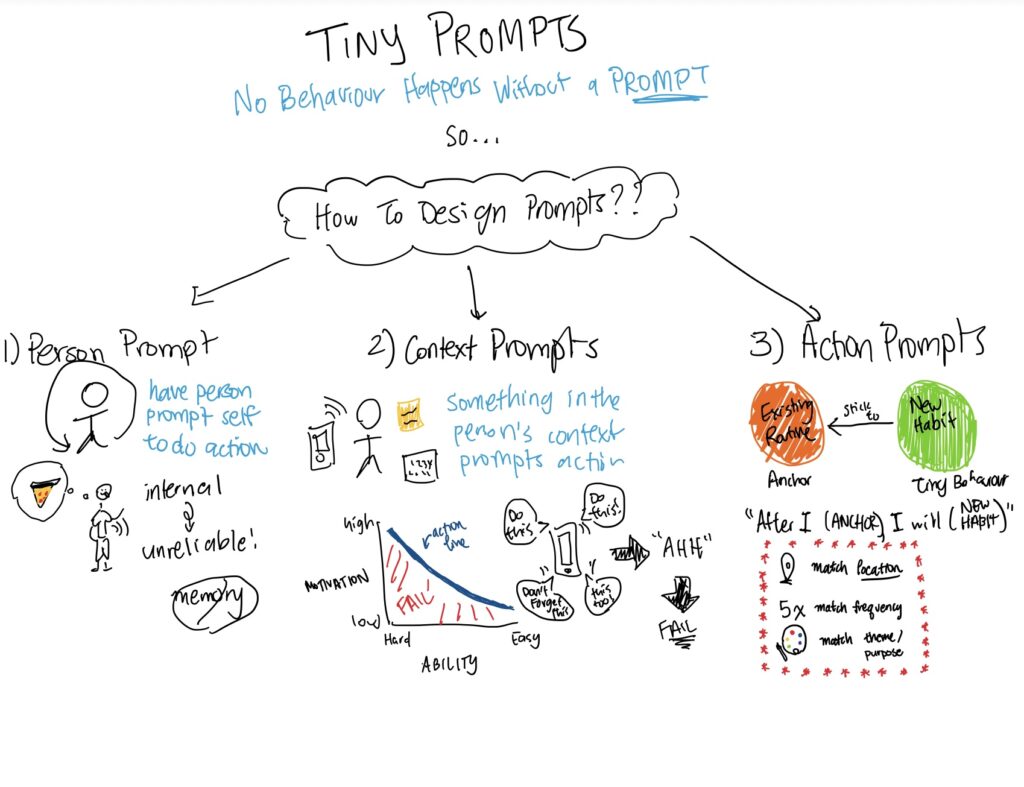Baseline Study
Study Overview
This baseline study aimed to examine how individuals engage with and maintain their posture throughout the day. It took the form of an observational approach to identify the factors contributing to poor posture, as well as participants’ awareness and habits related to posture. The key objectives were:
- Measure the frequency and context in which participants engage in poor posture
- Assess participants’ awareness of their posture and the effectiveness of reminders in improving it
- Identify common situations, behaviors, and environmental factors that contribute to poor posture
Study Methodology
This study was conducted over five days, during which participants received three daily text reminders prompting them to reflect on their posture. Additionally, they completed an end-of-day diary entry. Together, the text reminders and EOD form documented:
- Their posture at different times of the day
- The duration they remained in certain positions
- Any discomfort or pain they were experiencing
Post-study interviews were conducted to gain deeper insights, allowing participants to share their thoughts and personal experiences regarding their posture habits, challenges, and the impact of the reminders. The study collected quantitative data (posture frequency, duration, pain levels) as well as qualitative data (reflections on posture habits and awareness).
Participant Recruitment
Participants were recruited from the Stanford University undergraduate student population, and we considered if they experienced posture-related pain or problems, as well as their ability to participate in a five-day long study requiring frequent self-reflection. The accessibility and vast personal networks of undergraduate students allowed for effective data collection and engagement.
Key Research Questions
- How often do participants engage in poor posture throughout the day?
- In what specific contexts (e.g., studying, socializing, exercising) does poor posture most commonly occur?
- Do regular reminders effectively increase awareness and encourage self-correction?
- What factors – both environmental and behavioral – contribute to maintaining or failing to maintain good posture?
- How do participants perceive their own posture, and does their participation align with their actual habits?
Insights
Grounded Theories
Grounded Theory 1: People tend to be indifferent about their posture, especially when they are concentrating on other tasks, such as school work.
- Subtheory 1.1: People prioritize task completion over physical comfort, leading to prolonged poor posture
- Subtheory 1.2: Individuals only become aware of poor posture when they experience discomfort or pain.
- Subtheory 1.3: Digital distractions (phones, laptops) exacerbate posture neglect by increasing screen time and reducing movement.
Evidence:

Grounded Theory 2: Most of our customers, undergraduate students, don’t seem to have a proper ergonomic set-up where they can do work.
- Subtheory 2.1: College dorms and libraries prioritize space efficiency over ergonomic design.
- Subtheory 2.2: Students often work in multiple locations (cafés, libraries, beds) rather than a designated workspace.
Evidence:

Grounded Theory 3: People are self conscious about bad posture, but also self conscious about fixing their posture in public.
- Subtheory 3.1: Fixing posture in public (e.g., stretching, adjusting chair position) can draw unwanted attention. People fear being perceived as “overly concerned” with appearance when correcting posture.
- Subtheory 3.2: Social norms reinforce a “natural” sitting or standing posture, making exaggerated corrections seem awkward and weird.
- Subtheory 3.3: Peer influence can determine posture habits. If others slouch, individuals feel less pressure to sit upright.
Evidence:

Grounded Theory 4: Movement helps with improving posture but just because you workout doesn’t mean you have good posture.
- Subtheory 4.1: Some workouts strengthen muscles but do not address posture habits.
- Subtheory 4.2: Weightlifting without proper form can reinforce poor posture instead of correcting it.
- Subtheory 4.3: Activities like yoga and Pilates focus on posture awareness more than strength training does.
Evidence:

Grounded Theory 5: People are generally more likely in the morning to fix their schedule and run out of motivation and willpower in the evenings or the end of the day.
- Subtheory 5.1: Decision fatigue reduces people’s ability to maintain good habits throughout the day.
- Subtheory 5.2: Morning routines create a sense of structure, whereas evening routines are more relaxed and prone to slouching.
Evidence:

Grounded Theory 6: People spend most of their day either sitting or sleeping, and tend to have worse posture in these positions than when standing.
- Subtheory 6.1: The convenience of soft furniture (beds, couches) promotes slouching and poor posture.
- Subtheory 6.2: People prioritize comfort over ergonomics, leading to poor sitting habits.
Evidence:

Grounded Theory 7: Reminders seem to help with fixing posture, but are most effective early in the day and only remind them for a moment.
- Subtheory 7.1: Frequent reminders lose their effectiveness over time due to desensitization (because people start ignoring notifications).
- Subtheory 7.2: Reminders that incorporate feedback (like tracking progress over time) may be more motivating than random one-time alerts.
Evidence:

Other Photos (Insights in Class):

Timeline
Start of day:

Middle of day:

End of day:

System Models


Our system models encompass the main themes we saw across the different needfinding interviews we conducted (pre-study and post-study interviews). We saw how people tended to slouch due to common habits: checking their phones, relaxing on their couches/rooms, and working on homework. A main perpetrator of bad posture was the use of electronic devices. However something that kept coming up was how dressing up affected their self-image which in turn affected their posture. People felt like they had to live up to their outfit, therefore they would improve their posture. This helped us realize that people cared about their appearance, especially in the presence of others. As people go through the day, they tend to do more activities that will cause them to slouch–a lot of them which they cannot avoid because it is part of their life as a student. This raises the question of how we can help them improve their posture without disrupting their daily routines.
Secondary Research
Literature Review
In our previous blog post, we listed 11 pieces of literature that have aided our study design and summarized the key findings from each of them. From our research, one key insight is that poor posture is not only pervasive across different age groups and contexts but also leads to a variety of health challenges, including neck pain, back pain, and musculoskeletal discomfort. Sedentary lifestyles—from prolonged computer use among engineering students to children sitting in school settings—exacerbate posture-related problems. Across all these articles, there is a consistent theme: without conscious efforts or interventions, prolonged poor posture can result in chronic pain and diminished quality of life especially in our target audience.
Another major finding is the diverse range of interventions that have been tested to address or correct posture issues. Exercise programs, for example, were effective at reducing pain by emphasizing posture awareness while feedback devices, such as posture correction belts, and forward head posture gadgets, helped users recognize and correct posture in real-time. All in all, the most benefit may be had in combining both physical and behavioral strategies for optimal posture correction.
Comparative Research
Through our comparative research (in detail here), in mapping out the various posture-focused solutions—from wearable devices like UpRight GO and Lumo Lift to service-oriented offerings such as chiropractors and massage centers—we discovered each competitor addresses a unique market gap. For instance, posture-correction wearables tackle the immediate feedback gap that workout apps fail to address, while chiropractic care caters to individuals who need in-depth, professional realignment that neither a device nor an app alone can effectively provide.
While each option addresses specific aspects of posture correction, none of them provide a fully comprehensive solution that simultaneously delivers real-time feedback, long-term muscular reinforcement, and personalized holistic care to completely resolve the user’s posture challenges. For example, UpRight GO delivers real-time posture alerts that the Perfect Posture & Healthy Back App lacks, ensuring immediate correction when users slouch. However, the device alone doesn’t strengthen core muscles over time, while the App’s workout approach relies heavily on user discipline and offers no instant feedback.

On the other hand, chiropractors offer targeted, professional musculoskeletal adjustments that Strava doesn’t, directly addressing structural issues behind poor posture. Yet depending solely on in-person care can be costly and sporadic, whereas Strava’s active lifestyle approach is beneficial but lacks individualized posture correction.

[pages from Strava]
Our 2×2 map also highlights convenience factors: digital apps reduce barriers for busy individuals, yet they often lack the hands-on monitoring provided by professional care or physical braces.
By plotting these solutions on our 2×2 matrix, we recognized a trend toward increasingly automated or AI-powered feedback mechanisms. However, cost and user-friendliness still pose significant hurdles—especially for products requiring repeated in-person appointments or premium subscriptions.

Strengths of Competitors
- Real-Time Posture Feedback
- UpRight GO, Lumo Lift, AI Posture Reminder App
These competitors provide continuous, immediate alerts (vibrations or onscreen notifications) to help users correct slouching in the moment.
- UpRight GO, Lumo Lift, AI Posture Reminder App
- Holistic Professional Approach
- Chiropractors (e.g., Stanford Chiropractic Center)
Offers in-person evaluations and spinal alignments that address posture at its root causes, providing more comprehensive, medically informed solutions.
- Chiropractors (e.g., Stanford Chiropractic Center)
- Low Barrier to Entry
- PostureZone
Does not require additional hardware beyond a smartphone and is relatively affordable, making posture checks more accessible to a broad audience.
- PostureZone
- Aesthetic or Lifestyle Appeal
- Posture Pal Stuffed Animals, Copper Compression Brace
Provides a more “friendly” or discreet approach; users can incorporate posture support into everyday routines without feeling they’re wearing medical gear.
- Posture Pal Stuffed Animals, Copper Compression Brace
Weaknesses of Competitors
- Limited Accessibility & High Cost
- Chiropractors, Massage Centers
Require in-person visits or ongoing fees, making them less accessible to users who lack the time or resources to attend regular sessions.
- Chiropractors, Massage Centers
- No Real-Time Monitoring
- Perfect Posture & Healthy Back App, Strava
These rely on user self-discipline rather than giving continuous alerts; users may lose motivation or practice poor form between scheduled workouts or activity tracking.
- Perfect Posture & Healthy Back App, Strava
- Physical Intrusiveness or Discontinuation
- Copper Compression Brace, Lumo Lift
Braces can be uncomfortable or socially noticeable, while discontinued products like Lumo Lift offer limited support or updates.
- Copper Compression Brace, Lumo Lift
- Battery and Privacy Concerns
- AI Posture Reminder App, Strava
Continuous tracking can drain battery life; reliance on camera/GPS monitoring raises user privacy fears, potentially deterring consistent use.
- AI Posture Reminder App, Strava
Proto-Personas and Journey Maps
Jacob (J.R.)
| Drawing | Name | Jacob Rueman (J.R.) |
 |
Activated Role | College undergraduate student-athlete, basketball player |
| Goal | I want to fix my daily posture… | |
| Motivation | … because my bad posture becoming painful throughout the day, affecting my mood and physical abilities when in long classes, working, or exercising/lifting for my sport. | |
| Conflict | I am such a busy person, balancing college athletics along with school and having a social life that I find it hard to remember to fix my posture. It is also hard to stay in a good posture position when it is so unnatural to me, and I’m already tired a lot of the time. | |
| Attempts to Solve | I have tried to fix my posture when I remember or when I am having discomfort due to an unnatural sitting or standing position.
I have also worn a back brace during the school day, during practice, and during weights but it’s so uncomfortable and annoying. I have watched a few YouTube videos on posture correction but haven’t implemented any long-term strategies. I tried setting reminders on my phone, but I usually ignore them because I’m focused on other tasks. |
|
| Setting/ Environment | I notice my posture the most:
|
|
| Tools/Skills |
|
|
| Routines |
|
|
| Habits |
|

One of the personas that we chose was Jacob (aka JR). JR is a student-athlete who works out every day but still experiences bad posture and has problems with posture related to long work hours or extended phone and laptop usage for classes. He has a demanding schedule and finds it hard to remember to implement posture fixes throughout the day, losing awareness of the importance of sitting and standing in the correct position. Sometimes people assume that athletes and people who consistently work out automatically have good posture but this is not always the case, and JR is a representation of this.
It seems that JR’s posture is closely associated with his daily routines and habits, particularly the long hours spent sitting in class, studying, and carrying a heavy backpack while walking around campus. His demanding schedule leaves little room for conscious posture adjustments, and even when he tries to correct it, he often reverts back to slouching or leaning forward due to fatigue. While he has attempted solutions like using a back brace and setting personal reminders, these efforts have not led to lasting improvements. It is clear that JR’s posture struggle isn’t due to a lack of awareness but rather the difficulty of maintaining good posture amidst physical fatigue and a packed schedule. His experience highlights that traditional solutions like reminders and external supports may not be effective unless seamlessly integrated into daily life and routines.
Valeria
| Drawing | Name | Valeria |
 |
Activated Role | Undergraduate Student |
| Goal | I want to improve my posture | |
| Motivation | I don’t want to look ugly and feel unhealthy right now and later in my life | |
| Conflict | Wants to improve her posture but gets really lazy throughout the day and doesn’t do much to change her posture. | |
| Attempts to Solve | Attempts to remember to keep a good posture by being conscious of other people’s posture. She is constantly looking at others around her to help her remember that she has to correct her posture so she does not look like people who are slouching. | |
| Setting/ Environment | She mainly tries to solve her posture problem when she is around other people. Popular places in which she is most aware of others are in class, in the elevator, and during her club meetings. | |
| Tools | Does not currently own or use any inanimate tools to help her improve her posture. Closest to a tool that will help her improve her posture is her piano teacher that tells her to sit up straight when she is playing. | |
| Skills | Has a good memory that reminds her to improve her posture because she hears her grandmother’s voice in her head telling her to sit up straight. | |
| More | Routines: She has a pretty simple routine of driving to school from her apartment, going to class, going to her clubs, and then driving back to her apartment. She spends most of her time sitting down except for when she walks on the treadmill for 2 hours when gets back home. She tries to compensate for her lack of physical activity throughout the day by walking on the treadmill for hours on end.
Habits: She tends to lay around in her apartment a lot. She enjoys watching TV when she is back from school and does not have to do any work. She usually watches at least an hour of TV per day. During these moments she tends to relax and disregard her posture. She also observes people a lot and is wary about herself in the presence of others. She is always making sure she looks her best because she does not want to look bad in front of others. |

One persona we chose is an undergraduate student in West Virginia called Valeria. She is your typical undergraduate student that goes to class, does some homework, and goes to her weekly club meetings. However, she is also hyper aware of those around her, which provides some interesting insight into how she moves along throughout her day. Little things do matter to her, which makes her an interesting persona to study when it comes to posture. Her awareness of others serves her as a reminder to keep up her good posture, but what about when she is alone?
In her journey map, we see hints or subtle mentions of wanting to be healthier and feeling poorly about their posture. Both of these relate back to being perceived by others. Valeria is a relatively healthy individual except when it comes to some of her eating habits where she has to eat on the fly. However, this seems to affect her image as she wants to be seen as perfect as possible. This includes her dressing well and having good posture to live up to the outfit she is wearing. There seems to be a conflict at hand: Valeria wants to be as physically healthy as possible, but at the same time has trouble keeping up a healthy lifestyle. Can improving her lifestyle toward a healthier one be a solution to improving her bad posture habits? This is something we can figure out now thanks to this journey map that follows her throughout the day and tracks her thoughts and pain points.



